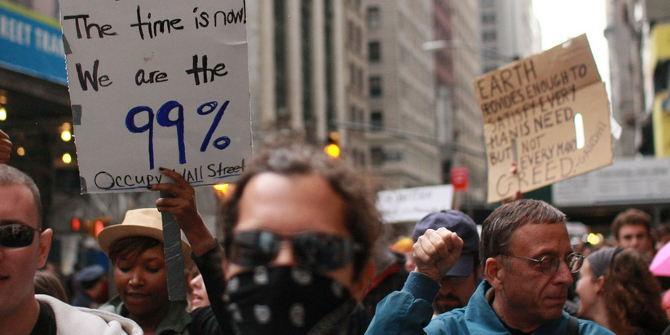
 Non-standard workers doing short-term, flexible jobs are a growing segment of the labour force, which poses difficult questions. Is it good policy to provide unemployment insurance to them? Do people engage in gig work by choice? And should they be rewarded for it? Jonas Kolsrud and Johannes Spinnewijn explore the issue and argue that many gig workers are likely to have few resources other than unemployment insurance when they become jobless.
Non-standard workers doing short-term, flexible jobs are a growing segment of the labour force, which poses difficult questions. Is it good policy to provide unemployment insurance to them? Do people engage in gig work by choice? And should they be rewarded for it? Jonas Kolsrud and Johannes Spinnewijn explore the issue and argue that many gig workers are likely to have few resources other than unemployment insurance when they become jobless.
More and more workers around the world are in “non-standard employment relations”, in which they are paid to complete specified tasks within a certain time. This new labour market poses challenges to social insurance systems in general and unemployment insurance in particular. At the heart of the issue is whether this type of work is a deliberate choice by workers or their only alternative after being denied regular employment. Individuals actively choosing gigs based on opportunity and preferences will value unemployment insurance differently than those on the fringes of the labour market doing non-standard work out of necessity.
The so-called “gig economy” has experienced substantial growth in recent years, fuelled by the rise of digital platforms like Uber and Deliveroo, which connect workers with short-term, flexible jobs, or gigs. A parallel development in many countries is the changed composition of the self-employed, with a marked increase of the share of the solo self-employed, those who do not have any dependent workers on their payroll.
This changing landscape is altering employment relations towards a labour market that is more flexible but also less predictable. As a consequence, a growing number of workers lack the social insurance protection typically found in standard work. One of the main reasons is the conflation of the traditional roles of employer and employee.
In the case of a layoff in a standard employer-employee relationship, the employer certifies that the layoff has occurred, that it’s involuntary and, in some countries, how much an individual has worked, to determine benefit eligibility. In a non-standard relationship, it’s only the worker who can inform the unemployment insurance agency about these things.
That information shortage is not being addressed, which excludes this segment of the labour force from unemployment insurance. Our research shows that while insurance for non-standard workers may have higher costs, these workers are also likely to put considerable value on access to unemployment benefits, which could outweigh the additional costs.
The value of insurance
To design optimal unemployment insurance benefits, value should equate cost. How much workers value insurance is chiefly determined by two factors: how much their consumption depends on it would they become unemployed, and how much they dislike risk.
Scholars often argue that the rise of gig work reflects a changing labour market where workers are seeking greater flexibility, independence, and control over their work lives. However, non-standard arrangements are growing fastest among people with a low degree of labour force attachment who have difficulties competing for traditional employment and may have little choice of jobs for which they can compete. Given this, we believe that gig workers are likely to benefit greatly from having access to unemployment insurance as they are likely to have few other resources to draw from if they become unemployed.
When it comes to gig workers’ risk preferences, a typical argument is that people who choose non-standard employment are also less averse to risk, which means that they should value unemployment insurance less. An opposing argument is that people can be forced into non-standard work by employers or individual circumstances. Evidence speaking to this is that people who are in non-standard work also often have fewer resources compared to the self-employed with dependent workers, and some studies also find their subjective well-being to be considerably lower. If selection into non-standard employment were voluntary, we wouldn’t necessarily expect these patterns.
Should gig workers be more dependent on unemployment insurance to finance their consumption, and should they not be less risk-averse than other workers, there is a case for providing them with access to unemployment insurance even if it would cost more in terms of longer unemployment spells compared to standard workers.
Costs
This type of insurance also comes with costs in terms of the transfers paid out and due to their prolonging effect on unemployment. Arguably, providing non-standard workers with insurance designed for standard ones can increase moral hazard costs. In this case, people may claim to be unemployed while they are actually unwilling to work, or they use unemployment insurance benefits as a type of “bridge financing” to cover temporary slumps in assignments.
Our research, though, shows that most of the effect of unemployment insurance generosity is concentrated on shorter spells, while explaining little of the variation in long-term unemployment risk.
This could, for instance, be addressed by having a flatter benefit profile instead of front-loading benefits early in the spell. We also show that people’s employment history prior to becoming unemployed is important. Those who have had lower tenure at their prior firm, who have been on unemployment or disability benefits before (and thus have been in and out of work prior to their present unemployment) are most at risk of long-term joblessness. This suggests that long-term unemployment is not so much a trap that people get stuck into, but a predictable risk falling on certain workers, and something we can see already at the start of the unemployment spell.
If we extend unemployment insurance coverage to non-standard workers, the question is whether the risk of long-term unemployment is greater among them compared to other workers. If those benefitting from insurance have a lower degree of labour force attachment, this could lead to higher costs for covering them. However, our research suggests that higher costs would not primarily be driven by unemployment insurance benefits per se, but rather by so-called dynamic selection – that people with lower labour force attachment are also the ones who find themselves out of work for extended periods of time.
An alternative to a universally mandated unemployment insurance is a voluntary one. This could be an option when some non-standard workers see little value in insurance and therefore would wish to abstain, while other workers value it higher. But it is also a way of letting non-standard workers bear a larger share of the cost for unemployment insurance provision.
Evidence on how this could work can be found in countries where parts of the unemployment insurance are voluntary. Sweden is one such example were workers who have qualified for insurance receive a basic benefit plus a voluntary top-up if they are members of an unemployment insurance fund. The top-up is financed both through premiums paid in by workers and state subsidies.
Of course, voluntary unemployment insurance raises concern about “adverse selection”. Individuals with the highest risks, and therefore highest costs, will be those who buy insurance while people with low risk opt out, generating large costs for insurance providers. Our research on the Swedish context shows that there is indeed adverse selection, but the resulting cost is not high enough to warrant a universal mandate. It should be noted, though, that making good choices is hard and it is typically highly educated individuals who gain from being able to make insurance choices.
In sum
The changing labour market with a growing share of non-standard workers pose challenges for unemployment insurance systems. Many of the concerns of moral hazard and adverse selection in unemployment insurance may be overstated, thus suggesting that an extension of insurance to non-standard workers is worthwhile.
Whether non-standard work is a deliberate choice or the only available option for some people is an important question. Workers who actively choose non-standard work out of preference will value unemployment insurance differently from those who do it out of necessity
Clearly, more empirical evidence needs to be brought to the table. The Swedish context provides an opportunity to investigate these questions more, especially as the self-employed can opt into the unemployment insurance system and coverage is not limited to involuntary separations. These are features that, as far as we are aware, have not been rigorously studied.
- This blog post is based on The Value and Limits of Unemployment Insurance, by Jonas Kolsrud and Johannes Spinnewijn, in LSE Public Policy Review, special issue on Changing Labour Markets and the Future of Social Protection and first appeared at LSE Business Review.
- Featured image provided by Shutterstock.
- Please read our comments policy before commenting
- Note: The post gives the views of its author, not of USAPP– American Politics and Policy, nor of the London School of Economics.
- Shortened URL for this post: https://wp.me/p3I2YF-dFS






